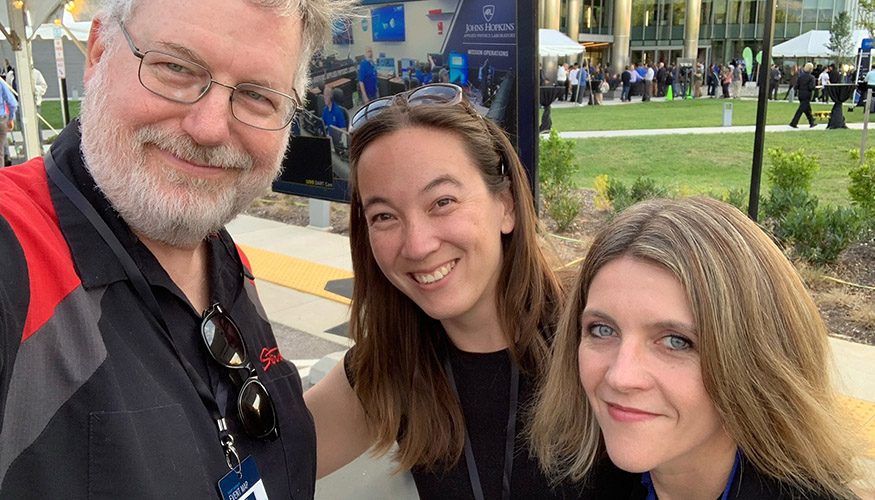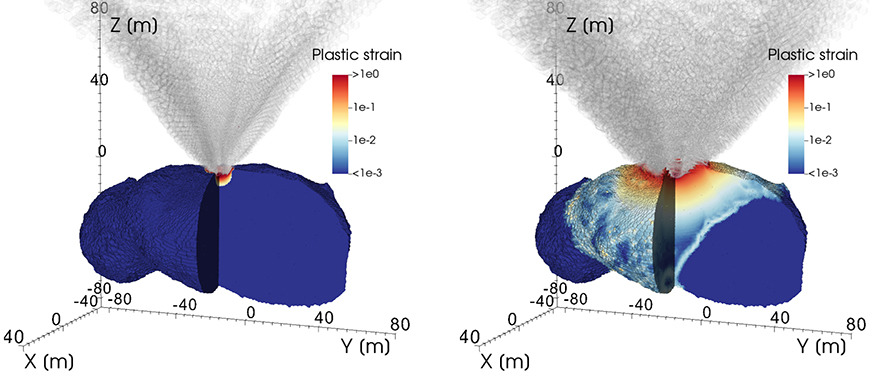Planetary defense
LLNL scientists use large-scale simulations on supercomputers to evaluate different methods for defending the planet from asteroid collisions.
Addressing a potential threat
Our planet has been continually bombarded by asteroids since its formation. While the frequency of large impacts has decreased, many potential Near-Earth Object (NEO) threats remain undiscovered, so if or when they will impact Earth remains unknown.
Most of the time, an impacting asteroid will simply burn up in the atmosphere, resulting in a meteor shower display. However, Earth-bound objects only a few kilometers across have already caused global catastrophes, such as the impact that wiped out all non-avian dinosaurs and many other species 66 million years ago and the more recent Chelyabinsk meteor, which injured hundreds of people and damaged many structures.
Our team of physicists, material scientists, geoscientists, engineers, and computational physicists are working with collaborators across several national labs, universities, and international research centers to develop methods for detecting and mitigating the next large Earth-bound object. Leveraging LLNL’s high-performance computing and high-energy-density capabilities, we characterize NEOs, simulate methods to nudge the trajectory of those that pose a threat, and model impact consequences to inform emergency response.
Disruption and deflection with nuclear explosives
For scenarios with little warning time before impact or when the object is large, the most effective approach is using a nuclear explosive to either disrupt or deflect the asteroid. Our team has developed the modeling capability to evaluate nuclear approaches that can be used to deflect (gently nudge) or disrupt (break up, disperse the fragments) an incoming asteroid.
Because asteroids and comets vary in size, density, composition, dynamics, and internal structure, we consider cases that span observed behavior and properties. We use different simulation capabilities, uncertainty quantification techniques, radiation hydrodynamics codes, and advanced algorithms to examine the physical processes involved in a nuclear detonation, the subsequent energy production and deposition, the material’s response, and debris dispersal after the disruption.
Our simulations of deflection by means of nuclear explosion have yielded valuable understanding of scenarios in which a large asteroid bears down on Earth with little warning. Additional research includes predictive modeling using energy and density inputs based on actual NEOs observed in the solar system. By better understanding the available threat-mitigation options and their outcomes, our models will help improve confidence in the effectiveness of a nuclear response should the need arise.
Characterizing asteroid material
Without convenient, cost-effective ways to experiment directly on asteroids in the solar system, we use high-energy-density experiments on asteroid fragments to validate and improve our models. These experiments leverage the high-power laser capabilities at LLNL’s Jupiter Laser Facility to study the samples under extreme conditions.
In one such study, we collaborated with the University of Oxford to conduct experiments on rare meteoritic samples using Janus, a kilojoule-class, neodymium-glass laser system. The results allowed us to gauge each sample’s strength and work on the material’s equation of state.
Validation with impact
Building on our previous simulation efforts, we have also modeled a nonnuclear deflection method known as kinetic impact. This method involves ramming an impactor—an uncrewed spacecraft—against an asteroid at high speeds, typically many kilometers per second (tens of thousands of miles per hour). The impact delivers the momentum of the spacecraft, plus additional momentum from cratering ejecta thrown off the asteroid’s surface. This momentum delivery slightly changes the asteroid’s velocity; if the velocity is changed with enough warning time, it can cause a potential Earth-impactor to miss the Earth. Even within the limited parameters for this method to work, the variables associated with the kinetic impact method are numerous. The research requires experts from many fields working together to build models incorporating realistic asteroid properties and to run simulations on large computer clusters.
This work led to our collaboration with NASA and the Johns Hopkins Applied Physics Laboratory to support NASA’s Double Asteroid Redirection Test (DART) mission, the first demonstration of the kinetic impactor technique to change the motion of an asteroid in space. DART targeted Dimorphos, a small moonlet (150-meter diameter) orbiting a larger asteroid, named Didymos (800-meter diameter). Targeting a binary asteroid allowed a precise measurement of the velocity change imparted by DART by measuring the orbital period before and after the impact, using Earth-based telescopes. In preparation for DART, our team investigated various impact scenarios and developed new methods to simulate the range of possible asteroid targets and to model the DART spacecraft with higher fidelity. The LLNL-developed Spheral code was used to carry out all the impact simulations provided by LLNL in support of the DART mission.
Shortly after the DART impact experiment, NASA announced that the spacecraft successfully changed the asteroid’s motion in space, shortening the orbital period from 11 hours and 55 minutes to 11 hours and 23 minutes. Our researchers are using this period change measurement, combined with the final images of Dimorphos from the DART spacecraft and other data from Earth- and space-based telescopes, to determine what target properties are consistent with the asteroid’s change in velocity. Using DART’s final pre-impact images, the team will also build a realistic target shape and structure while implementing high-fidelity models of the DART spacecraft’s geometry.
Making the world safer
Our planetary defense program grew out of the capabilities and expertise developed and refined in LLNL’s weapons program. LLNL is one of a few places worldwide with the simulation capability and the knowledge of nuclear-explosives effects to conduct this research. By applying our expertise to extraterrestrial threats, we continue to support and expand the Laboratory’s mission to make the world a safer place.
Other teams at LLNL contribute to planetary defense by pursuing hazardous asteroid discovery and orbit characterization using astronomical surveys and advanced data science techniques. For more information, see the Optical astronomy and cosmology research page.
Image gallery
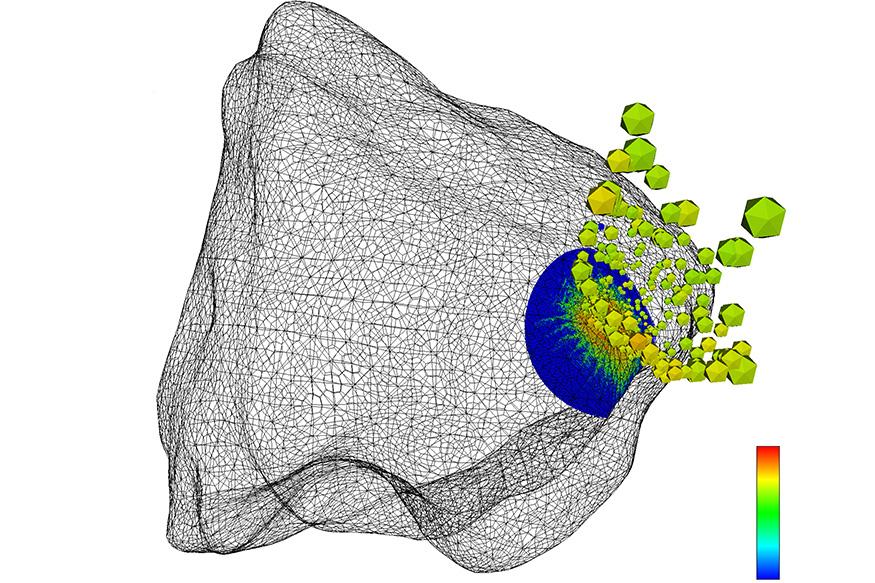

A Spheral model of the asteroid Golevka as it is impacted by a 10,000-kilogram mass traveling at 10 kilometers per second. Ejected pieces breaking away from the asteroid add to the total momentum imparted to the body, helping further nudge it away from its Earthbound course.
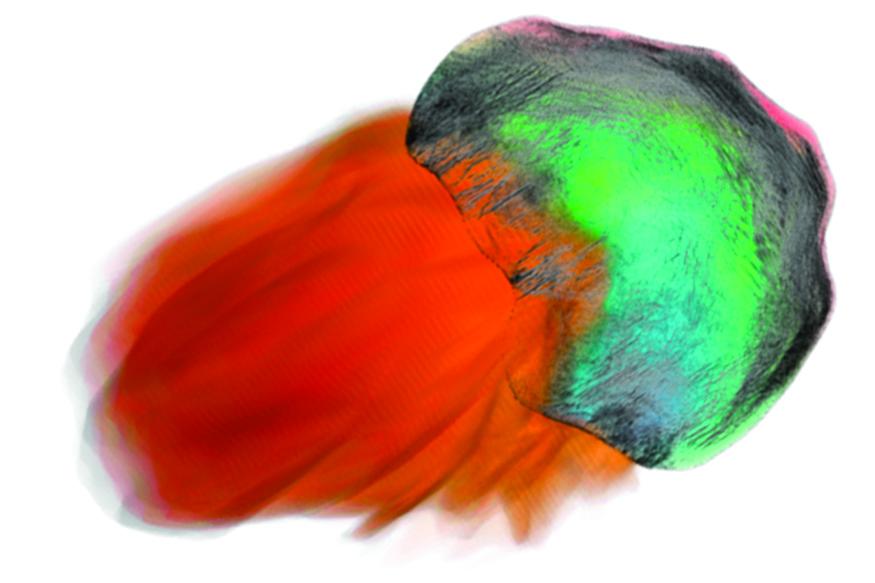

GEODYN simulated this scaled model of the Geographos asteroid, which shows a realistically shaped object about 500 meters in diameter, driven by a 750-kiloton nuclear explosion that deposited 150 kilotons of energy. Orange indicates variations in the ejecta’s energy density, the blue–green hues show deviatoric stress levels, and gray represents damage.
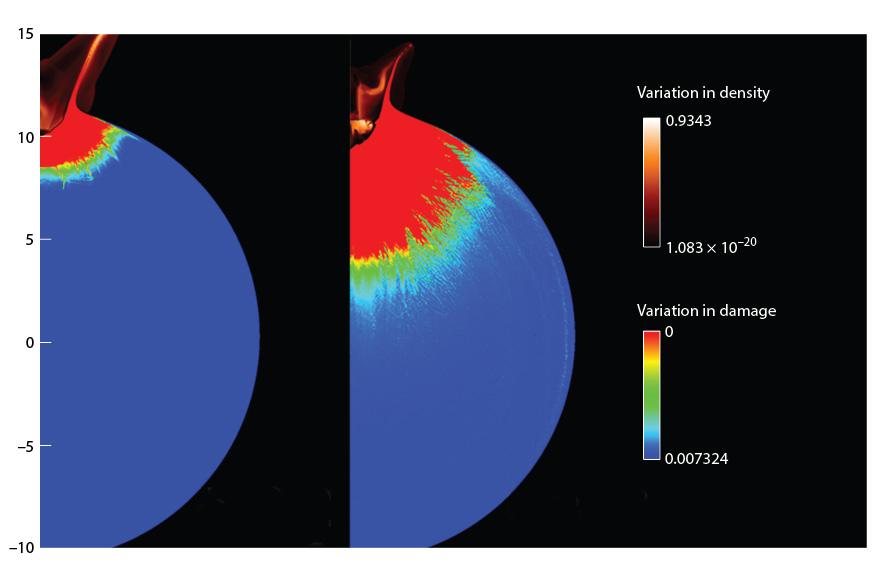

GEODYN simulations show the effect of bulk porosity on an object’s response to a hypervelocity impact. The blue–red color scale depicts the degree of damage inflicted on an object with bulk porosity of (left) 20 and (right) 30 percent. A material’s strength decreases as porosity increases, which affects the amount of damage and cratering.
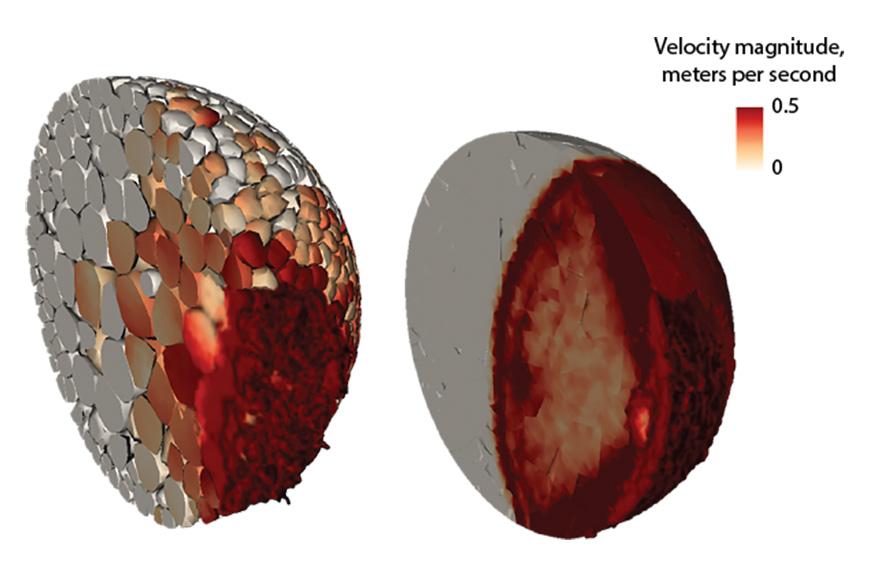

GEODYN-L simulations compare two realizations of porous asteroids, each with 2,380 individual pieces in a (left) rubble pile and (right) fractured consolidated configuration. The incident wave is at approximately the same location at (left) 7.1 and (right) 0.9 seconds, indicating a large contrast in response. Material near the energy deposition region vaporizes, melts, or fails, contributing to blowoff that imparts momentum to the remaining assembly of boulders.
People
| Name | Title | Discipline |
|---|---|---|
| Team | ||
Collaborators
Johns Hopkins University Applied Physics Laboratory (JHUAPL)
NASA Goddard Space Flight Center (GSFC)
NASA Ames Research Center (ARC)
NASA Jet Propulsion Laboratory (JPL)
NASA Marshall Space Flight Center (MSFC)
NASA Johnson Space Center (JSC)
Los Alamos National Laboratory (LANL)
Sandia National Laboratory (SNL)
University of Colorado Boulder
University of Maryland, College Park
Observatoire de la Côte d'Azur (Nice Observatory)
Select publications
Effects of Impact and Target Parameters on the Results of a Kinetic Impactor: Predictions for the Double Asteroid Redirection Test (DART) Mission | Planetary Science Journal, 2022
A.M. Stickle, M.E. DeCoster, C. Burger , W.K. Caldwell, D. Graninger, K.M. Kumamoto, R. Luther, J. Ormö, S. Raducan, E. Rainey, C.M. Schäfer, J.D. Walker, Y. Zhang, P. Michel, J.M. Owen, O. Barnouin, A.F. Cheng, S. Chocron, G.S. Collins, T.M. Davison, E. Dotto, F. Ferrari, M.I. Herreros , S.L. Ivanovski, M. Jutzi, A. Lucchetti, E. Martellato, M. Pajola, C.S. Plesko, M. Bruck Syal, S.R. Schwartz, J.M. Sunshine, K. Wünnemann
FSISPH: An SPH formulation for impacts between dissimilar materials | Journal of Computational Physics, 2022
J.M. Pearl, C.D. Raskin, J.M. Owen
Predicting Asteroid Material Properties from a DART-like Kinetic Impact | The Planetary Science Journal, 2022
K.M. Kumamoto, J.M. Owen, M. Bruck Syal, J. Pearl, C. Raskin, W.K. Caldwell, E. Rainey, A.M. Stickle, R.T. Daly, and O. Barnouin
Spacecraft Geometry Effects on Kinetic Impactor Missions | The Planetary Science Journal, 2022
J.M. Owen, M.E. DeCoster, D.M. Graninger, and S.D. Raducan
Impact of neutron energy on asteroid deflection performance | Acta Astronautica, 2021
L.S. Horan, D.E. Holland, M. Bruck Syal, J.E. Bevins, J.V. Wasem
Late-time small body disruptions for planetary defense | Acta Astronautica, 2021
P.K. King, M. Bruck Syal, D.S.P. Dearborn, R. Managan, J.M. Owen, C. Raskin
Benchmarking impact hydrocodes in the strength regime: implications for modeling deflection by a kinetic impactor | Icarus, 2020
A.M. Stickle, M. Bruck Syal, A.F. Cheng, G.S. Collins, T.M. Davison, G. Gisler, N. Güldemeister, T. Heberling, R. Luther, P. Michel, P.L. Miller, J.M. Owen, E.S.G. Rainey, A.S. Rivkin, T. Rosch, K. Wünnemann
Numerical Simulations of Laboratory-Scale, Hypervelocity-Impact Experiments for Asteroid-Deflection Code Validation | Earth and Space Science, 2020
T.P. Remington, J.M. Owen, A.M. Nakamura, P.L. Miller, and M. Bruck Syal
Options and uncertainties in planetary defense: Impulse-dependent response and the physical properties of asteroids | Acta Astronautica, 2020
D.S.P. Dearborn, M. Bruck Syal, B.W. Barbee, G. Gisler, K. Greenaugh, K.M. Howley, R. Leung, J. Lyzhoft, P.L. Miller, J.A. Nuth, C.S. Plesko, B.D. Seery, J.V. Wasem, R.P. Weaver, M. Zebenay
Simulations of high-velocity impacts on metal in preparation for the Psyche mission | Icarus, 2020
C. Maurel, P. Michel, J.M. Owen, R.P. Binzel, M. Bruck Syal, and G. Libourel
Validating Ice Impacts using Adaptive Smoothed Particle Hydrodynamics for Planetary Defense | Proceedings of the 2019 Hypervelocity Impact Symposium, 2019
D. Graninger, M. Bruck Syal, J.M. Owen, P.L. Miller
Options and uncertainties in planetary defense: Mission planning and vehicle design for flexible response | Acta Astronautica, 2018
B.W. Barbee, M. Bruck Syal, D.S.P. Dearborn, G. Gisler, K. Greenaugh, K.M. Howley, R. Leung, J. Lyzhoft, P.L. Miller, J.A. Nuth, C.S. Plesko, B.D. Seery, J.V. Wasem, R.P. Weaver, M. Zebenay
Modeling impact outcomes for the Double Asteroid Redirection Test (DART) mission | Procedia Engineering, 2017
A.M. Stickle, E.S.G. Rainey, M. Bruck Syal, J.M. Owen, P.L. Miller, O.S. Barnouin, C.M. Ernst
Shape Dependence of the Kinetic Deflection of Asteroids | Journal of Guidance, Control, and Dynamics, 2017
J.D. Feldhacker, M. Bruck Syal, B.A. Jones, A. Doostan, J. McMahon, D.J. Scheeres
Deflection by kinetic impact: Sensitivity to asteroid properties | Icarus, 2016
M. Bruck Syal, J.M. Owen, and P.L. Miller
Excavating Stickney Crater at Phobos | Geophysical Research Letters, 2016
M. Bruck Syal, J. Rovny, J.M. Owen, P.L. Miller

